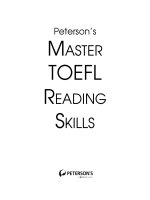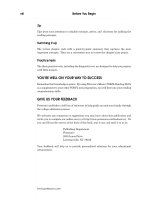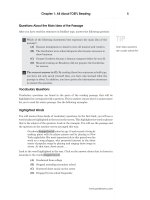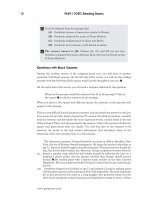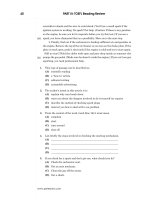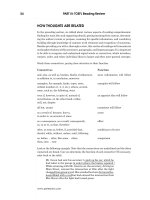Peterson’s master toefl reading skills part 28 pdf
Bạn đang xem bản rút gọn của tài liệu. Xem và tải ngay bản đầy đủ của tài liệu tại đây (71.31 KB, 7 trang )
180 PART V: Appendixes
www.petersons.com
The Academic Calendar
American colleges operate on three main types of calendars that divide the year into
terms: the semester, trimester, and quarter systems. The academic year is approxi-
mately nine months long no matter how it is divided. The semester system divides that
nine months in half, resulting in fall and spring semesters. Schools that use the
trimester and quarter systems divide the same nine months into three 3-month terms.
The summer term is the fourth quarter in the quarter system, and enrollment in classes
is optional. For most institutions the academic year runs from late August or September
to May or June. Many schools operate all year long, and students can often take courses
over the summer term for an additional fee.
There are usually two examination periods in each term, one in the middle and one at
the end. Holiday schedules vary with each school, but there are usually a number of
short holidays in each term, a longer break in December and January, and a weeklong
vacation period in early spring. International students who want or need to stay on
campus during holiday periods should find out from the housing office if this is possible
and if there is any additional charge.
Faculty Members and Methods of Instruction
Students and faculty members typically interact less formally in U.S. undergraduate
programs than they do elsewhere in the world. They often develop close relationships
or friendships. The size of the institution and the size of the class will be important
factors. Professors sometimes ask students to join them for lunch or participate with
them in community activities. Each professor has his or her own personality and style
but, in general, faculty members at U.S. schools are more accessible than faculty
members in many other countries.
The classroom experience is frequently characterized by discussion between the
professor and the students. A portion of a student’s grade for a course is often
determined by the quality of participation in class discussions. It is unusual to find a
course where the entire grade is based on one examination at the end of the term.
International students should be prepared to participate in class discussions since
classmates and professors will expect it. Most faculty members are aware that cultural
factors and English language skills may initially make participation difficult for
international students. With time, most international students find that this participa-
tion adds a great deal to the learning process.
There are three basic methods of instruction. Large introductory-level courses are
usually taught through lectures at which several hundred students gather to hear a
professor speak. The small class or seminar includes a group of 5 to 30 students. This
method is generally used in more advanced courses and allows for more interaction
between the students and the professor. Laboratory sections are similar to seminars and
are usually required with courses in the sciences or applied fields like computer science
or engineering.
08_TOEFLReadingAppB,177-206 7/29/06, 12:53180
Appendix B: Applying to Colleges and Universities in the U.S. 181
www.petersons.com
Almost all colleges offer opportunities for students to work individually with professors
in tutorials or independent study courses.
Academic and Personal Advising Systems
An attractive feature of U.S. higher education is the support and counseling that
students receive.
International or Foreign Student Adviser. Most U.S. colleges and universities have an
international office with trained professionals available to counsel students from other
countries on a broad range of matters, including:
• Orientation to campus and community life
• Immigration and visa
• Employment and practical training
• Off-campus and social activities and opportunities
• Personal and health concerns
• General academic planning
• Financial problems
Faculty Adviser. At most schools, each student is assigned a faculty adviser. The
assignment is usually based on the student’s field of study. Faculty advising includes
the following areas:
• Requirements for degrees
• Selection of academic courses
• Academic performance and progress
Peer Counselor. Many colleges have developed a system of peer counseling for students.
The counselors are upperclass students and provide the student viewpoint on academic
and personal matters.
Outside the Classroom
An important part of your educational experience in the United States will be
participation in nonacademic, social, and extracurricular activities on campus. Many
opportunities are available for students to become involved in sports, student
government, music, drama, and other organized and individual activities. Such
activities are designed to contribute to your personal growth, provide recreation,
create opportunities to meet new people with similar interests, and help prepare you
for future leadership roles upon graduation. Participation in these activities is not
required to obtain a U.S. degree. These are optional activities, but they play a central
role in campus life at U.S. colleges and universities.
08_TOEFLReadingAppB,177-206 7/29/06, 12:53181
182 PART V: Appendixes
www.petersons.com
HOW TO DETERMINE WHICH COLLEGES ARE BEST FOR YOU
Choosing which colleges and universities to apply to is a difficult task when you are not
familiar with the United States and its system of education. With so many institutions
to choose from, it is necessary to approach your choice in a logical way to arrive at a list
of schools that would be best for you.
Now, consider the following list when looking at colleges. How important is each one to
you? Rank them in order from one through eight, according to your own priorities.
Cost
Look for the total cost of tuition, fees, and room and board. You will need additional
funds for books and other living expenses. If you need financial aid, are grants available?
Compare the number of international students enrolled to the number of awards given
and the average amount granted. This will give you an idea about the possibility of
receiving one of these awards and how much it might help you to meet your need.
Enrollment
Look at the total and undergraduate enrollments. Is this the right size school for you?
Find the percentage of international students and how many countries are represented.
Does it have the blend of U.S. and international students you are looking for?
Entrance Difficulty
Find the entrance difficulty for U.S. students. Compare the number of international
students who applied to the number accepted. This will tell you how difficult it is to gain
admission.
Location
Consider where the institution is located. What is the climate in that area of the country?
Is the campus setting urban, suburban, small-town, or rural? Would you be happy living
in this type of area?
Housing
Is on-campus housing available and guaranteed? Is it available during the summer and
during breaks if you need it?
08_TOEFLReadingAppB,177-206 7/29/06, 12:53182
Appendix B: Applying to Colleges and Universities in the U.S. 183
www.petersons.com
Library Holdings and Facilities
Refer to the information on library holdings and other facilities, such as laboratories,
computer labs, and athletic facilities, to make certain they meet your needs.
Type of Institution
Is it a two-year or four-year institution? Is it public or private? Is it religious or
proprietary? These are all important factors to consider in the decision-making process.
English as a Second Language (ESL) Program
Is there an intensive English language program available (if needed)?
Decide what you want and need concerning each of the previous items. Review the
institutions on your first list. Eliminate those that do not meet the criteria that are
important to you. For example, if you cannot afford more than $10,000 each year,
eliminate those institutions with combined tuition and fees and room and board that
come close to that amount, unless you are especially interested in a particular
institution and it offers financial aid for which you are confident you will qualify. If you
want to attend an institution in a particular state or area of the United States, eliminate
those schools that do not fit that category. If you are sure that you want to attend a large
public institution, you can eliminate the schools that do not match this criterion. You
should now have a much shorter list of colleges that may be good choices for you.
Select seven to ten institutions that seem to meet your needs the best. This is your
second list. Be sure to request application materials as early as possible. It is best to
start this process sixteen months before the date you intend to enter college.
While you wait for the answers to your requests for further information, determine
which standardized admission tests you need to take. Most schools require the College
Board’s SAT or the American College Testing’s ACT Assessment (ACT). A few require
the College Board’s SAT Subject Tests. In addition, the Test of English as a Foreign
Language (TOEFL) is generally required for international students who do not speak
English as a native language. You will want to avoid having to take additional tests after
receiving application materials from individual institutions because it will slow down
the application process.
Review the materials that you receive and any information on these schools that is
available in the advising office in your school or the center where you received this
publication. Reduce your list to three to five colleges and universities by reviewing the
following information:
08_TOEFLReadingAppB,177-206 7/29/06, 12:53183
184 PART V: Appendixes
www.petersons.com
• Detailed description of the overall academic program
• Specific course offerings and faculty information
• Academic facilities (libraries, computer, and laboratory facilities)
• Detailed description of the campus and surrounding community
• Housing, financial aid, and ESL (if needed)
• Extracurricular, cultural, and religious activities that are important to you
This is your third and final list for application purposes.
APPLYING
Once again, be sure to request application materials as early as possible. It is best to
start this process sixteen months before the date you intend to enter college. In addition,
the way you complete your application and present yourself is very important and will
play a big part in determining the outcome of your efforts to gain admission. If you want
to find a college or university that is able to meet your needs, it is very important for you
to be completely honest and sincere in the information you provide to them.
Carefully read the application and information that you have received from each school.
It will tell you how the school sees itself, its mission, philosophy, and educational goals.
Once you know what a specific college values and emphasizes, you will have some idea of
what aspects of your own background and goals to emphasize as you prepare your
application. More important, getting a broad sense of the school will help you determine
if it is a place where you would fit in and be comfortable and happy. Admission officers will
be doing exactly what you did to prepare for applying. They will attempt to determine how
your abilities, goals, and interests match what they have to offer and what kind of
contributions you might be able to make to the college and its students. You should present
yourself in your best light, but do not give incorrect information. Admission officers can
usually tell when an application statement does not sound like the truth. In addition, the
legal implications of giving false information about yourself can be very serious.
A complete application that is ready to be evaluated by the admission committee
typically contains the following:
• Fully completed preliminary (if required) and final application forms
• Teacher recommendations (if required)
• Secondary school report (if required)
• Transcripts and academic records
• TOEFL or other English language proficiency test scores (if required and applicable)
• Standardized test scores (SAT, ACT, and SAT Subject Tests if applicable)
• Nonacademic information as requested by the college or university
• Financial aid application (if applicable)
• Application fee
08_TOEFLReadingAppB,177-206 7/29/06, 12:53184
Appendix B: Applying to Colleges and Universities in the U.S. 185
www.petersons.com
Preliminary Applications
Some colleges require international applicants to complete a preliminary application.
If a school uses this process, you will receive a preliminary application with the
materials they send to you. The preliminary application helps admission officers
determine whether or not you will be a likely candidate before you go through the more
complicated process of completing the final application form.
The preliminary application will request basic information about you and may also ask
for a brief statement of your goals. Your statement should indicate the reasons why you
feel the school would be a good place for you and what contributions you can make to life
on campus. Return the preliminary application as quickly as possible.
If the admission officer finds that your goals, abilities, and general background are
compatible with what that particular college is looking for, you will be sent the final
application to complete. If it is determined that you are not a competitive candidate, you
will be notified of this decision and can then focus your attention and energy on the other
schools you have selected.
Final Applications
It is important to complete the final application and provide all the required information
and documents the college has requested as quickly as possible. The sooner the college
receives your application and all the required supporting documents, the sooner they
will be reviewed and evaluated. An application submitted early can only help your
chance of being offered admission and will give you extra time to supply additional
information if it is requested.
Personal Information
The personal information requested on an application form is an important part of the
complete application package. You will likely be asked to answer a variety of questions
about yourself—your abilities, goals, special talents, and why you wish to attend that
particular college. Many international applicants have wonderfully rich backgrounds
and experiences they can share.
Most admission officers will take into account that you are from another culture and,
if applicable, that English is not your native language. Share your experiences and your
enthusiasm as clearly as you can. Samples of your writing, art work, or tapes of musical
performances, as applicable to the program of study you wish to pursue, may be included
if you wish. If any portion of the application does not apply to you, note that on the form,
along with an explanation. For example, many secondary schools in other countries
have fewer school-sponsored activities than U.S. high schools. Some schools do not
award academic honors. These situations should be explained.
08_TOEFLReadingAppB,177-206 7/29/06, 12:53185
186 PART V: Appendixes
www.petersons.com
Keep in mind that the personal information asked for on the application will provide
admission officers with the information they need to get to know you as a person, not just
your academic achievements and test results. Make the most of this opportunity.
Teacher Recommendations
Policies regarding teacher recommendations vary from college to college, but you should
be prepared to have at least one teacher provide a reference for you. Select someone who
knows you well and has taught you in a subject that is related to the course of study you
are thinking of following at college. If you are undecided about a specific course of study,
then it is wise to select a teacher who knows you well and has a high regard for you
academically and personally.
You have the option of making these recommendations confidential between the letter
writer and the college. Many teachers, headmasters, principals, and tutors will often
write a more open recommendation if they know it will be confidential.
Secondary School Reports and Transcripts
The school report and the transcript of your academic record are essential to the
evaluation of your academic abilities. The report form should be filled out by the official
in your school who is responsible for college placement. This is usually a counselor,
principal, headmaster, or careers master. This form should introduce you in the context
of your whole school experience in relationship to the other students in your class.
Admission committees will be interested in learning how you have performed in your
own educational system. The school report should talk about your accomplishments and
provide a prediction of your chances for success in university-level studies.
Your official transcript or academic record is the objective part of your application.
Academic records vary greatly from one education system to the next. Systems of
evaluation or grading and the formats used to present this information also differ widely.
Ask your school to include a guide to the grading standards used in the educational system
in your country and for your school specifically. If your school ranks students by their level
of academic achievement, make certain the ranking is included with the information they
send. It will provide an easily understood picture of how well you have done. If your school
does not rank students, an estimate of your rank (for example, top 10 percent) would be
helpful. Admission officers will want to know how you have performed over time, so be sure
to have records sent that describe your academic performance for the past three to four
years. If there is a national school-leaving certificate examination at the end of secondary
education in your country (such as British GCSE’s or British-based O and A Levels,
French Baccalaureat, German Abitur, Hong Kong Certificate of Education, etc.), have
official results sent as soon as they are available.
If your transcripts, academic records, and leaving-certificate examination results are
not in English, make sure that you have officially certified literal English translations
of all documents sent along with the official documents in the original language.
08_TOEFLReadingAppB,177-206 7/29/06, 12:53186
